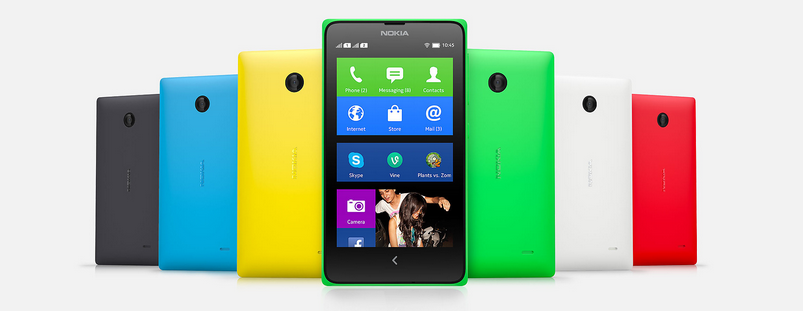
Nokia has finally launched an Android phone. Though it takes the form of a low-end product, and could be killed as soon as Nokia is absorbed into Microsoft next month, the implications are fairly large.
For starters, Nokia has a history of creating devices with open source operating systems; Symbian, which Nokia essentially controlled, was available to developers and modders, and the form it eventually took was informed by many of those outside Nokia itself. The (in)famous Nokia N9, based on a heavily customized version of MeeGo was, while not a commercial successor, a darling among early adopters and has since emerged a cult favourite.
It’s not exactly clear why Nokia decided to venture once more into the depths of open source, especially at this juncture; with the purchase of the Finnish company’s hardware division by Microsoft nearing completion, its autonomy is not long for the open market, and Microsoft could shut the whole X project down. But should it?
The Problem
The problem for Microsoft is simple: it’s been struggling since 2011 to turn Windows Phone into a viable third competitor in the mobile space. It has done this by supporting less expensive hardware, charging its partners (including Nokia) less money in licensing fees, adding popular apps like Instagram, Vine, Path and WhatsApp (and soon, BBM), and pushing into emerging markets that until now only had poorly-performing Android hardware to deal with. There is a reason the $149 Lumia 520 is the world’s most popular Windows Phone.
But Microsoft’s ascent to third place has been stilted, awkward and more than occasionally frustrating. While Windows Phone’s development tools are of notably high quality, and developer loyalty extremely high, the absence of big-name apps like Instagram negatively affected the platform for too long. Now that the major gaps have been filled, the question of user engagement — and revenue generation — remains an issue. It’s even been difficult for developers to adapt HTML5-based apps for Windows Phone because Internet Explorer’s rendering engine, Trident, differs from the WebKit base of mobile Safari and Chrome for Android.
The Question
So why did Nokia build an Android phone? Well, in many ways they didn’t. They took the core Android Open Source Project code and built a layer of Microsoft services on top; there isn’t a hint of Google on the device, from the default search engine to the mail client to the navigation and music software. Indeed, this is more a Windows Phone than a low-end Android.
For Nokia, the benefits are clear: they get to offer (and appease) Microsoft and its core benefits — Bing search, Outlook mail, HERE Maps — while differentiating from Windows Phone itself by offering a host of Android apps that are currently unavailable on Microsoft’s own mobile OS. On top of that, Nokia has redesigned the Android interface to look and feel almost identical to a Windows Phone, live tiles and all, while keeping one of Android’s best and most extensible features, its notification drawer. Nokia is also encouraging X users to sideload apps unavailable in the Nokia Store, a nod to the inevitable tinkerers who will customize the phone to the nines. BlackBerry 10 has supported this since its inception, and has somewhat bridged that app gap, but the Nokia X supports Android code natively, and should be able to run games, even with its piddling 1Ghz dual-core processor, at decent speeds.
The Winners
Who wins here? Almost everyone. Google’s win is narrow but significant: it takes potential market share away from Windows Phone, even if Google itself won’t officially “accrue” new Android users, as the Nokia X line lacks the company’s Play Services framework. And while Google won’t see advertising revenue from search, maps or email, many existing Android apps — and they can be sideloaded if unavailable in Nokia’s app store — will derive revenue their numerous ad platforms. Google also wins because Microsoft gets to curtly approve, behind gritted teeth, of Nokia using Android.
Microsoft wins because its services are splayed all over the X platform, and because they will use Nokia’s Android line as a gateway drug to bigger, better, more expensive Lumias. The more app cross-pollination Nokia manages to create, bringing its own first-party services like HERE Maps and MixRadio to Android, the easier it will be for Microsoft to attract users to its own mobile OS. Microsoft’s willingness to port its own apps and services to Android — Office Mobile, Outlook, OneDrive, OneNote, Xbox Music, etc. — will stand it in good stead going forward. Ultimately, because Microsoft still derives most of its revenues from Windows and Office, it’s probably more important to the executive team for Android users to be on Microsoft services than abandoning ship altogether for Google or Apple.
Nokia also stands to win big here, but it will take volume shipments to turn this into a successful venture. The company is already fully entrenched in the Windows Phone ecosystem, and that isn’t going to change, but being able to leverage a free, open-source operating system like Android allows for Nokia-specific customizations that wouldn’t be possible with Microsoft. And, if the X platform is successful, it could be used by Nokia within Microsoft to leverage change to Windows Phone itself, something that Stephen Elop and Co. have been trying to accomplish for years.
See our full Nokia X coverage for more.


